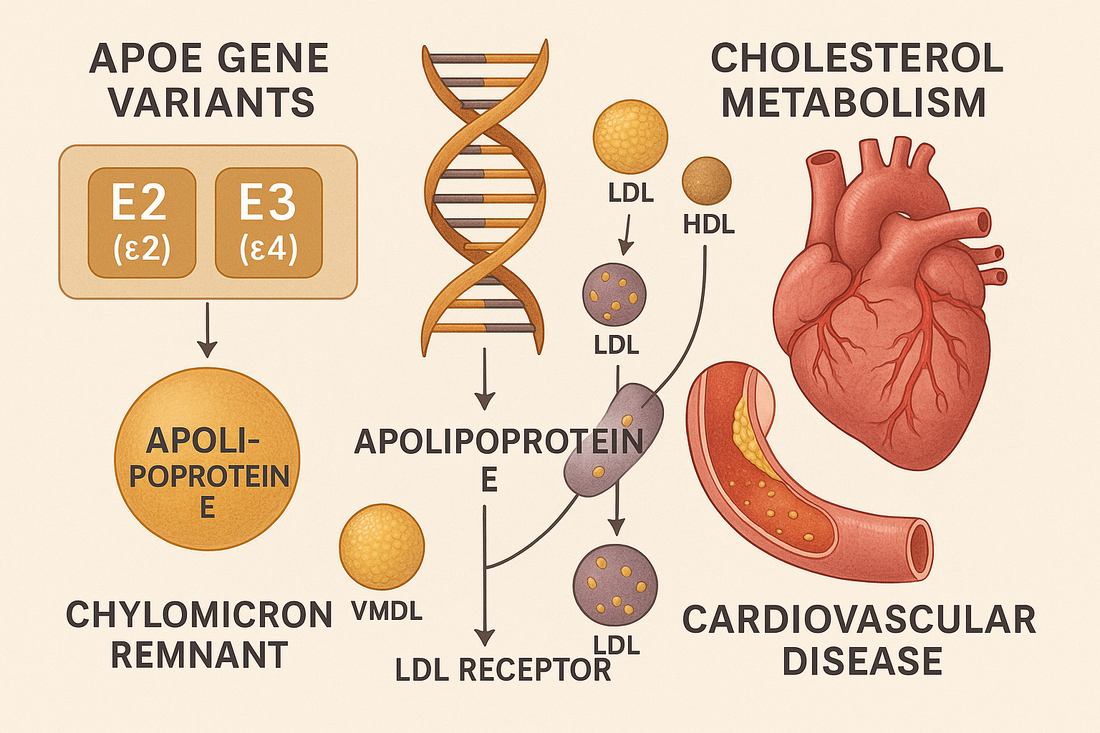APOE Gene Variants: A Key Determinant of Cholesterol Metabolism and Cardiovascular Risk
Introduction
The Apolipoprotein E (APOE) gene, located on chromosome 19q13.2, encodes a protein essential for lipid transport and clearance. APOE binds to lipoprotein particles and interacts with LDL receptors to clear triglyceride- and cholesterol-rich particles from circulation.
Three common alleles—E2, E3, and E4—combine into six possible genotypes. Each allele profoundly influences cardiovascular risk:
-
E3 (most common): Neutral, considered the “wild type.”
-
E2: Reduced LDL clearance, risk of hypertriglyceridemia.
-
E4: Higher LDL, increased risk of atherosclerosis and Alzheimer’s disease.
Your CardiaX test identifies which APOE alleles you carry, providing actionable insight into cholesterol management and cardiovascular disease prevention.
APOE Function in Lipid and Vascular Health
-
Cholesterol metabolism: APOE mediates clearance of chylomicron remnants and VLDL from the bloodstream.
-
Reverse cholesterol transport: Supports HDL’s role in removing cholesterol from arterial walls.
-
Inflammation: APOE modulates immune responses, influencing vascular inflammation.
-
Neurovascular link: APOE alleles affect not only cardiovascular risk but also brain health.
APOE Variants and Cardiovascular Implications
APOE2 (Cys112, Cys158)
-
Effect: Reduced binding to LDL receptor.
-
Lipid profile: Low LDL-C, higher triglycerides.
-
Risk: Associated with type III hyperlipoproteinemia and premature CVD when homozygous (E2/E2).
APOE3 (Cys112, Arg158)
-
Effect: Normal receptor binding.
-
Lipid profile: Considered neutral.
-
Risk: Baseline population risk for CVD.
APOE4 (Arg112, Arg158)
-
Effect: Increased binding to VLDL, impaired cholesterol transport.
-
Lipid profile: Elevated LDL-C, reduced HDL-C.
-
Risk: Strongly associated with atherosclerosis, coronary heart disease, and Alzheimer’s disease.
Clinical Outcomes by Genotype
-
E2/E2: Rare; high risk for hypertriglyceridemia and remnant lipoprotein buildup.
-
E2/E3: Generally protective against CAD, but risk of elevated triglycerides.
-
E3/E3: Neutral, average population risk.
-
E3/E4: Higher LDL-C, modestly elevated CVD risk.
-
E4/E4: Highest LDL-C and CVD risk, particularly with poor lifestyle habits.
What Worsens APOE-Associated Risk?
-
High saturated fat diet: Particularly harmful in E4 carriers, raising LDL-C substantially.
-
Alcohol: Exacerbates hypertriglyceridemia in E2 carriers.
-
Obesity and insulin resistance: Worsen lipoprotein clearance inefficiencies.
-
Sedentary lifestyle: Impairs lipid metabolism and increases inflammation.
-
Smoking: Potentiates atherogenic risk in all carriers, especially E4.
How to Mitigate APOE-Associated Risk
1. Lifestyle Strategies
-
E2 carriers: Limit alcohol and refined carbs to reduce triglycerides.
-
E4 carriers: Adopt a Mediterranean or plant-forward diet with low saturated fat intake.
-
All genotypes:
-
Exercise: Improves HDL and promotes lipoprotein clearance.
-
Weight management: Reduces insulin resistance and lipoprotein burden.
-
Smoking cessation: Essential for reducing vascular inflammation.
-
2. Nutraceuticals
-
Omega 1300 — Omega 1300: Improves lipoprotein clearance, lowers triglycerides.
-
CoQ10 Omega — CoQ10 Omega: Supports endothelial function, particularly in E4 carriers.
-
Niacin: Reduces triglycerides in E2 carriers.
-
Curcumin Complex — Curcumin Complex: Lowers vascular inflammation.
-
Magnesium glycinate: Supports metabolic flexibility.
3. Peptide Therapies
-
BPC-157: Repairs vascular endothelium.
-
MOTS-c: Improves insulin sensitivity and mitochondrial function.
-
KPV: Anti-inflammatory, reduces plaque vulnerability.
4. Medications
-
Statins: Particularly effective in E4 carriers to lower LDL-C.
-
Fibrates: Useful in E2 carriers with hypertriglyceridemia.
-
PCSK9 inhibitors: Strong LDL-C reduction, beneficial in E4 carriers.
-
Ezetimibe: Reduces cholesterol absorption, useful adjunct in high-risk carriers.
Case Example
A 50-year-old man with APOE3/E4 genotype presents with elevated LDL-C and a family history of coronary artery disease.
Plan:
-
Lifestyle: Mediterranean diet, elimination of trans fats, daily aerobic exercise.
-
Supplements: Omega 1300, CoQ10 Omega, Curcumin Complex.
-
Medications: Initiated on statin therapy.
-
Peptides: MOTS-c prescribed for improved metabolic control.
Outcome: LDL-C reduced by 50%, improved energy, and carotid intima-media thickness stabilized over 2 years.
The Bottom Line
The APOE gene polymorphism is one of the strongest genetic determinants of lipid metabolism and cardiovascular disease risk.
-
E2 carriers: Watch triglycerides, alcohol, and carbohydrate intake.
-
E3 carriers: Standard risk, focus on lifestyle maintenance.
-
E4 carriers: Highest risk—require aggressive LDL-lowering and anti-inflammatory strategies.
By using CardiaX results, clinicians can personalize interventions across diet, supplements, peptides, and medications to reduce cardiovascular risk.
References
-
Mahley RW, et al. Apolipoprotein E: cholesterol transport protein with expanding role in cell biology. Science. 1988.
-
Bennet AM, et al. Association of APOE genotypes with lipid levels and coronary risk. JAMA. 2007.
-
Eichner JE, et al. Apolipoprotein E polymorphism and cardiovascular disease: a meta-analysis. Lancet. 2002.
-
Ward H, et al. ApoE genotype, lipids, and coronary heart disease risk: a prospective study. Arterioscler Thromb Vasc Biol. 2009.


